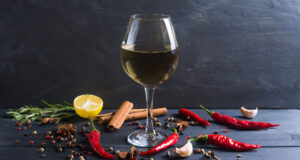There’s a plethora of advice on the internet on food and wine pairing. Some simplistic, and others require a PhD to decipher.
In part one of this series of posts on food pairing, I’ve tried to break down a few of the basics. While at first glance it seems intimidating, there are some basic rules, and I’ve added context to them below.
Pair food to wine, not wine to food
The first thing to understand is that while wine is not technically a living organism, it behaves like one both in the bottle and in the glass. Wine evolves over time with exposure to air — what the wine tasted like when initially bottled will be very different from when it is released to the public, let alone 10–20 years of aging. Furthermore, when wine is exposed to air either when opened, or in a wine glass, the evolution is accelerated.
Food on the other hand behaves the opposite. As soon as the produce is picked, or meat butchered, it begins degrading in quality — food, by definition, is dead. Furthermore, as soon as the cook finishes preparation of a dish, the quality again begins to deteriorate.
Given that wine continually evolves, and food degrades, it is important to pair food to the wine, as opposed to the opposite.
Keeping this in mind, there are two schools of thought when pairing food to a wine, however they are not exclusive from each other.
Complement vs. contrast
The first, and most common is complementing, that is food is chosen based on the overall weight of the wine, structure, or any flavor components found in the wine.
The other school of thought is finding food that contrasts the wine — bringing out subtle characteristics in the wine that may at first not be apparent.
Example of complement vs. contrast: Oysters
Complement: A wine with high acid and salinity notes, such as 2020 Drouhin Vaudon Chablis, NV Marc Hebrart Blanc De Blancs Champagne, 2020 Chateau Guipiere ‘Clos Des Morinieres’ Muscadet Sevre Et Maine Sur Lie, or even an old school Albarino from Rias Baixas, Spain such as 2021 Pedralonga. These bottles would enhance the brininess of oysters, as well as highlight the acidity. They do not, however, coax any subtle nuance and richness out of an oyster.
Contrast: A white wine with a rich texture and rounded flavors, such as a Chardonnay from Puligny (2019 Olivier Leflaive Puligny-Montrachet) or Chassagne Montrachet (2020 Roux Pere & Fils Chassagne-Montrachet) in Burgundy. This would amplify the richness and nuttiness of oysters and balance out the salinity.

Pair 2020 Drouhin Vaudon Chablis with oysters to compliment the wine.
Stay within the region
One thing to keep in mind with pairings is to consider what foods are traditional from the region in which the wine is made, most specifically in the Old World. In Europe, wine is as important as any component in a meal, and traditional foods of the region are specifically created to pair well with the wine. There is also a synergy between what is naturally grown in a region, and the characteristics found in the wine. Cassoulet is an incredibly rich dish from southeastern France full of sausage, duck confit, bacon, and pork fat — all characteristics found within that region’s wine such as Domaine Faury’s 2020 St. Joseph Rouge or Domaine Du Vieux Telegraphe’s 2019 Telegramme Chateauneuf-Du-Pape. Piedmont is famous for truffles and risotto, and the wine from the region carries on very similar notes such as Paolo Scavino’s 2018 Barolo. Even within the French alps around Lake Annecy, which is famous for trout, the wine is crisp with rounded minerals and a subtle texture that pairs brilliantly with this coveted fish. Roger Labbe’s 2020 Vin De Savoie Abymes would be a perfect example. The list goes on and on.
Balance complexity
Another way to approach pairing is to counter the complexity of the wine with that of the food. In general, the more complex the wine, the simpler the food should be. Why is Bordeaux such an amazing wine with steak? Besides the wonderful acid found in great Bordeaux cuts through the fattiness of steak, the steak does not overpower the complexity of the wine, allowing all the nuance to be enjoyed. Note that simplistic food does not necessarily mean a simplistic recipe. While most European dishes use very few ingredients, this is not always the case. This refers to the complexity of flavors.
On the other hand, simplistic wine should be paired with complex food. Many recipes in the New World, with the amalgam of various cultures and philosophies found in these countries, often serve food with a wide range of textures and flavors with a proportionately high number of ingredients. Coincidentally, while not exclusively, the wine produced in the countries tend to be more simplistic in nature, with lower acidity and higher alcohol. These foods pair wonderfully with these wines.

Consider structure
Lastly, but not least importantly, is understanding that the weight and structure of food should be paired with wine of equal structure. For example, why does a heavy red wine such as Cabernet Sauvignon not pair well with a light fish? The tannins overpower the delicacy of the fish, and can even result in an unpleasant metallic flavor. However, a light red wine such as Pinot Noir pairs beautifully with fatty and rich fish as the tannins are soft, and acidity higher to balance out the fattiness found in the food.
A wine pairing quick guide
Below is a quick template of what grapes go best with what food. There are obviously exceptions, but it’s a quick and easy guideline. We will go further in depth in future articles, so stay tuned. I’ve included quick links for different regions next to each variety.
What wine goes with rich red meat?
e.g. ribeye, beef roasts, venison
| Full-bodied red wine |
|---|
| Cabernet Sauvignon: Napa, Bordeaux, Australia |
| Syrah: Central Coast, Northern Rhone, Australia |
| Zinfandel: California |
| Petit Sirah: California |
What wine goes with light red meat/wildfowl?
| Medium-bodied red wine or full-bodied white wine with high acidity |
|---|
| Grenache: Southern Rhone |
| Nebbiolo: Barolo or Barbaresco |
| Sangiovese: Tuscany |
| Tempranillo: Rioja or Ribera del Duero |
| Merlot: Bordeaux, California |
| Pinot Noir: Burgundy, Oregon, Sonoma Coast |
| Riesling: Germany, Australia, Alsace, Washington State, New York State |
| Chardonnay: Burgundy, Sonoma |
What wine goes with poultry?
| Rich white wine or light-bodied red wine |
|---|
| Pinot Noir: Burgundy, Sonoma Coast |
| Gamay: Beaujolais |
| Chardonnay: Burgundy, Sonoma Coast, Oregon |
| Riesling: Germany, Australia, Alsace, Washington State, New York State |
| Chenin Blanc: Loire Valley, South Africa |
What wine goes with rich fish?
| Heavy white wine or red wine with low tannins |
|---|
| Pinot Noir: Burgundy, Oregon, Sonoma |
| Chardonnay: Burgundy, California, Oregon |
| Riesling: Germany, Australia, Alsace, Washington State, New York State |
| Pinot Gris/Grigio: Alsace, Italy |
What wine goes with light fish?
| Delicate white wine with high acidity |
|---|
| Chardonnay: Chablis, Oregon |
| Dry Riesling: Germany, New York State |
| Melon de Bourgogne: Loire Valley |
| Pinot Grigio: Italy |
What wine goes with spicy food?
| Wine with sweetness and higher acidity |
|---|
| Sweet or half dry Riesling: Germany |
| Gewurztraminer: Alsace |
| Chenin Blanc: Loire |
| Pinot Gris: Alsace |





